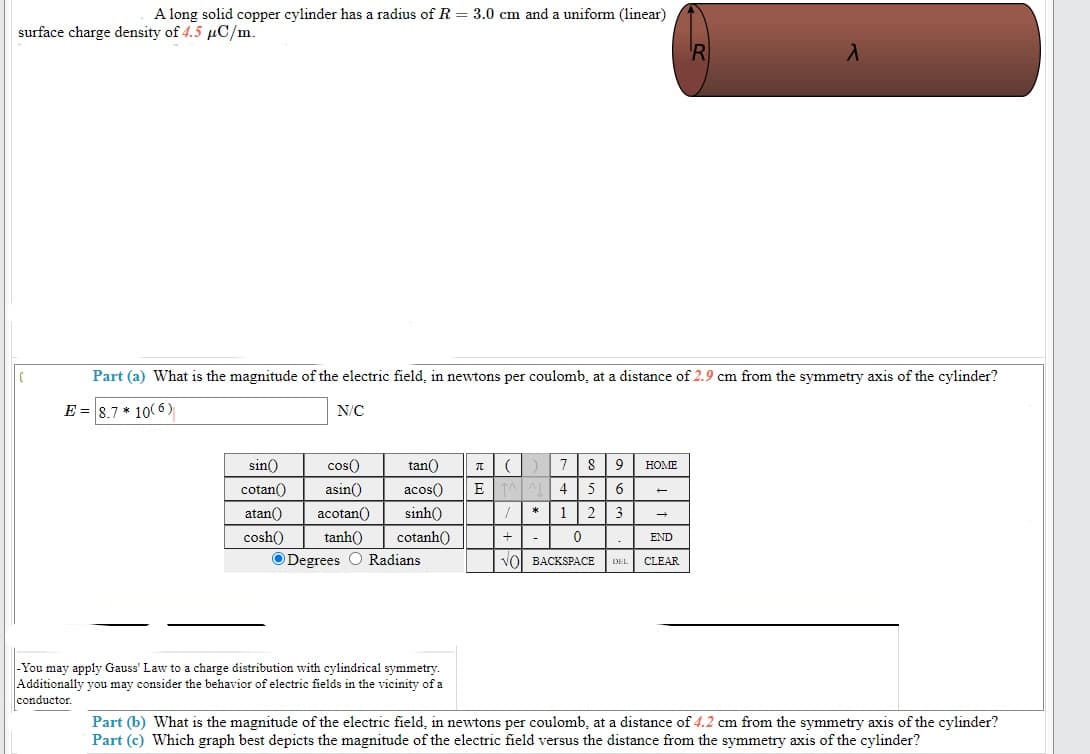A long solid copper cylinder has a radius of R = 3.0 cm and a uniform (linear) surface charge density of 4.5 µC/m. Part (a) What is the magnitude of the electric field, in newtons per coulomb, at a distance of 2.9 cm from the symmetry axis of the cylinder? E = 8.7 * 10( 6) N/C sin() cos() tan() HOME cotan() asin() acos() E 4 5 6 atan) acotan() sinh) 1 2 3 cosh() ODegrees O Radians tanh() cotanh) END Vol BACKSPACE CLEAR DEL |-You may apply Gauss' Law to a charge distribution with cylindrical symmetry. Additionally you may consider the behavior of electric fields in the vicinity of a conductor. Part (b) What is the magnitude of the electric field, in newtons per coulomb, at a distance of 4.2 cm from the symmetry axis of the cylinder? Part (c) Which graph best depicts the magnitude of the electric field versus the distance from the symmetry axis of the cylinder?
A long solid copper cylinder has a radius of R = 3.0 cm and a uniform (linear) surface charge density of 4.5 µC/m. Part (a) What is the magnitude of the electric field, in newtons per coulomb, at a distance of 2.9 cm from the symmetry axis of the cylinder? E = 8.7 * 10( 6) N/C sin() cos() tan() HOME cotan() asin() acos() E 4 5 6 atan) acotan() sinh) 1 2 3 cosh() ODegrees O Radians tanh() cotanh) END Vol BACKSPACE CLEAR DEL |-You may apply Gauss' Law to a charge distribution with cylindrical symmetry. Additionally you may consider the behavior of electric fields in the vicinity of a conductor. Part (b) What is the magnitude of the electric field, in newtons per coulomb, at a distance of 4.2 cm from the symmetry axis of the cylinder? Part (c) Which graph best depicts the magnitude of the electric field versus the distance from the symmetry axis of the cylinder?
Related questions
Question

Transcribed Image Text:A long solid copper cylinder has a radius of R = 3.0 cm and a uniform (linear)
surface charge density of 4.5 µC/m.
Part (a) What is the magnitude of the electric field, in newtons per coulomb, at a distance of 2.9 cm from the symmetry axis of the cylinder?
E = 8.7 * 10(6)
N/C
sin()
cos()
tan()
8
9
HOME
cotan()
asin()
acos()
4
5
atan()
acotan()
sinh()
12
3
cosh()
tanh()
cotanh()
+
-
END
ODegrees O Radians
VOI BACKSPACE
CLEAR
DEL
-You may apply Gauss' Law to a charge distribution with cylindrical symmetry.
Additionally you may consider the behavior of electric fields in the vicinity of a
conductor.
Part (b) What is the magnitude of the electric field, in newtons per coulomb, at a distance of 4.2 cm from the symmetry axis of the cylinder?
Part (c) Which graph best depicts the magnitude of the electric field versus the distance from the symmetry axis of the cylinder?
Expert Solution
This question has been solved!
Explore an expertly crafted, step-by-step solution for a thorough understanding of key concepts.
This is a popular solution!
Trending now
This is a popular solution!
Step by step
Solved in 4 steps with 4 images
